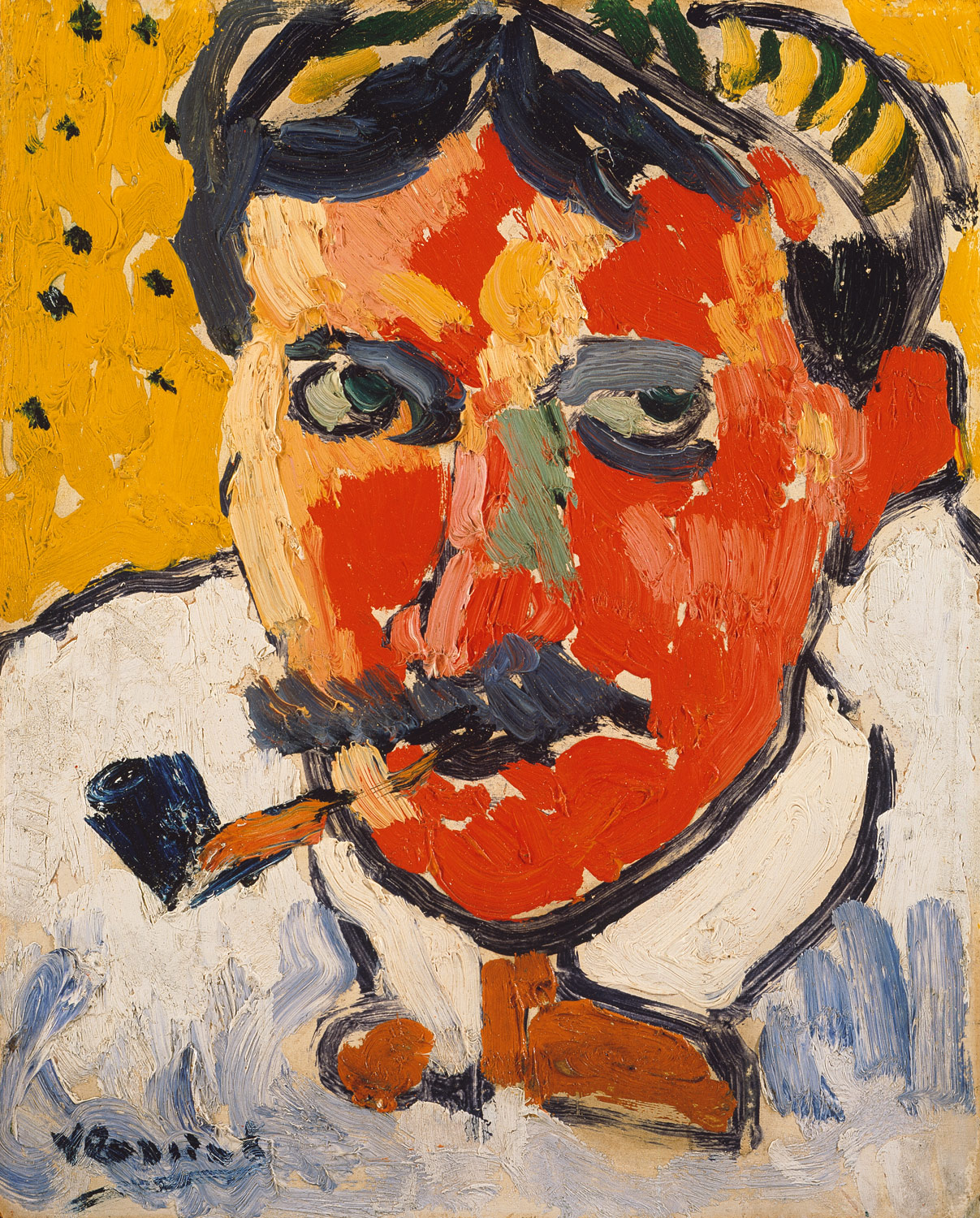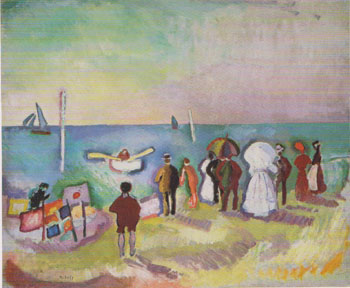Matisse and the Fauves, the Albertina, 20 September 2013 – 12 January 2014
Fauvism is the first and briefest avant garde movement of the 20th century. It lasted only
three years, from 1905 to 1907/8. The designation is derived from the description of their
works in a critique of the legendary Paris Autumn Salon of 1905. Henri Matisse, the chief
member of the group, and his friends André Derain, Maurice de Vlaminck and Henri
Manguin were defamed in it as "Fauves", wild animals or beasts. In fact, Matisse and his
friends revolutionised the conception of art.
They liberated painting from the dictates of the imitation of nature. The artists captured
their motifs with arbitrarily selected and intensely brilliant colours, sketchy brushstrokes
and unmodeled colour areas. They were provided with important impulses by Van Gogh and
his pastose brushstroke, by Cezanne and his unfinished canvasses, as well as by the
scientific colour theories of Paul Signac. They were reinforced in their new aesthetic by the
sculptures of Africa and Oceania.
At seven stations, the Albertina provides insight into these impressive years of the incipient
avant garde: at the start of the exhibition, the visitor submerges into the prehistory of
Fauvism, into the years 1900-1905, while Matisse, Marquet and Manguin were searching for
their places in the contemporary avant garde.
This is followed by a selection of high quality works painted by Matisse and Derain in the
summer of 1905 in Collioure in southern France, and then exhibited in the following
October in the Autumn Salon. Highlights of this section and of the exhibit as a whole are
the
Open Window by Henri Matisse,
views of Collioure:

by Matisse

and Derain
and portraits of one another painted by the two artists:

André Derain
Henri Matisse, 1905
Oil on canvas
Tate, London © VBK, Vienna 2013

Henri Matisse
Portrait of Andre Derain, 1905
Tate Gallery, London, UK
At the same time, Maurice de Vlaminck arrived at similar results in northern France while
painting untouched and hidden landscapes in the vicinity of Paris. With Raoul Dufy, Emile-
Othon Friesz and Georges Braque, a younger generation also finds its voice in the exhibit.
They were originally from Le Havre and would join the Fauves only a few months after the
legendary Autumn Salon of 1905.
Beyond this, the exhibit dedicates a chapter to the drawings and watercolours of the
Fauves: the exceptional importance of the works on paper for Fauvism is recreated on the
basis of 60 large scale examples. The sketchiness, the white paper background also
incorporated into the representation and the intense application of paint anticipate the
liberties taken in the paintings on canvas.
Finally, another chapter treats the influence of African sculptures on the Fauves. Matisse,
Derain and Vlaminck were the first artists, with the exception of Picasso, to collect non-
European artefacts. These encounters with African art, for example, in the case of Derain
during his stay in London and after a visit to the British Museum, set the direction for the
future. The exhibit brings together rare examples of African sculpture from the estates of
Matisse, Vlaminck and Derain.
The most important series of landscape paintings of Fauvism also originated in the British
capital. The Albertina is showing eight central works of Derain, which he painted in
response to Monet's Impressionist interpretation of diffuse light in London.
The next-to-last chapter addresses the bronze sculpture so important to Fauvism. The
Albertina is showing an important cross-section of bronzes created by Matisse between
1901 and 1909, with which he freed himself from traditional sculpture and the Impressionist
model.
Finally, the two loners of Fauvism, Georges Rouault and Kees van Dongen, are represented
with impressive paintings. Both artists influenced Fauvism with individual solutions and
highly autonomous methods.
With 160 works from more than 50 lenders from around the world, the Albertina exhibit is
the first broadly based show in Austria to comprehensively pay tribute to this important
avant garde movement. It was curated by Heinz Widauer in Vienna and Claudine Grammont
in Paris; an extensive catalogue summarises the important aspects of Fauvism for the first
time in German.

André Derain
The Pool of London, 1906/07
Oil on canvas
Tate, London © VBK, Vienna 2013

Henri Matisse
Still Life with Red Carpet, 1906
Oil on canvas
Musée de Peinture et Sculpture, Grenoble © Succession H. Matisse/VBK, Vienna 2013
Henri Matisse
The Open Window, 1905
Oil on canvas
National Gallery of Art, Washington Collection of Mr. and Mrs. John Hay Whitney © Succession H. Matisse/VBK, Vienna 2013

Henri Matisse
Parrot Tulips, 1905
Oil on canvas
Albertina, Batliner Collection © Succession H. Matisse/VBK, Vienna 2013

Henri Matisse
The Roofs of Collioure, 1905
Oil on canvas
The State Hermitage Museum, St. Petersburg, Foto: The State Hermitage Museum /Vladimir Terebenin, Leonard Kheifets, Yuri Molodkovets © Succession H. Matisse/VBK, Vienna 2013

André Derain
The Golden Age, ca. 1905
Watercolor
Collection Triton Foundation, The Netherlands © Succession Matisse/VBK, Vienna 2013

Henri Matisse
La Moulade, 1905/06
Oil on canvas
Private Collection © Succession H. Matisse/VBK, Vienna 2013

Henri Matisse
Gipsy Woman, 1905/06
Oil on canvas
Musée national d'Art moderne - Centre Georges Pompidou, Paris, Photo: Centre Pompidou, MNAM-CCI, Dist. RMN-Grand Palais / Philippe Migeat © Succession H. Matisse/VBK, Vienna 2013

Henri Matisse
Marguerite Reading, ca. 1906
Pen and black ink on paper
The Museum of Modern Art, New York. Acquired through the Lillie P. Bliss Bequest © 2013. Digital image, The Museum of Modern Art, New York/Scala, Florence © Succession H. Matisse/VBK, Vienna 2013

André Derain
Collioure, 1905
Oil on canvas
Scottish National Gallery of Modern Art, Edinburgh, Photo: National Galleries of Scotland © VBK, Vienna 2013

André Derain
The Girls, 1905/06
Watercolor and pencil on paper
Musée national d'Art moderne - Centre Georges Pompidou, Paris, Photo: Centre Pompidou, MNAM-CCI, Dist. RMN-Grand Palais / Philippe Migeat © VBK, Vienna 2013

André Derain
Big Ben, 1906/07
Oil on canvas
Musée d'Art moderne, Troyes, Photo: RMN-Grand Palais / Gérard Blot © VBK, Vienna 2013

Georges Rouault
Aunt Sallys (The Wedding of Nini-patte-en-l'air)
Watercolor, gouache, ink and crayon on paper
Musée national d'Art moderne - Centre Georges Pompidou, Paris, Photo: Centre Pompidou, MNAM-CCI, Dist. RMN-Grand Palais / Philippe Migeat © VBK, Vienna 2013

Albert Marquet
Posters at Trouville, 1906
Oil on canvas
National Gallery, Washington, Collection of Mr. and Mrs. John Hay Whitney © VBK, Vienna 2013

Maurice de Vlaminck
André Derain, 1906
Oil on canvas
The Metropolitan Museum of Art, New York, Photo: bpk © VBK, Vienna 2013

Maurice de Vlaminck
Pond at Ursine near Chaville, 1905
Oil on canvas
Collection Triton Foundation, The Netherlands © VBK, Vienna 2013

Georges Braque
Seascape, 1906
Oil on canvas
Madrid, Museum Thyssen-Bornemisza © VBK, Vienna 2013

Georges Braque
Seated Nude Combing Her Hair, 1906
Oil on canvas
Milwaukee Art Museum, Gift of Harry Lynde Bradley © VBK, Vienna 2013
 1907
1907Oil on canvas
Albertina, Vienna - Batliner Collection © Robert Delaunay, L & M Services B.V. The Hague. Photo: © Fotostudio Heinz Preute, Vaduz

Kees van Dongen
The Gypsy (The Curious Girl), ca. 1910/11
Oil on canvas
L’Annonciade, Musée de Saint-Tropez © VBK, Wien 2013

Raoul Dufy
The Fourteenth of July at Le Havre (Street Decked with Flags), 1906
Oil on canvas
Albertina, Vienna, The Batliner Collection © VBK, Vienna 2013

Raoul Dufy
The Beach at Sainte_Adresse, 1906
Oil on canvas
Arp Museum Bahnhof Rolandseck, Collection Rau for UNICEF © VBK, Vienna 2013

Henri Manguin
The Prints, 1905
Oil on canvas
Madrid, Museum Thyssen-Bornemisza © VBK, Vienna 2013

Louis Valtat
The Red Rocks at Agay, 1903
Oil on canvas
Collection Fondation Regards de Provence, Marseilles © VBK, Vienna 2013